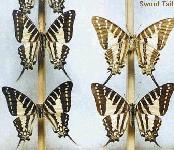

![]()

 Of
the 240 spe cies of butter flies identified in Sri Lanka, 60 are now
extinct, says Mr. Weeratunga, Curator in entomology (study of insects), at the
National Museum in Colombo. Among them are some of the most beautiful and rare
endemic species.
Of
the 240 spe cies of butter flies identified in Sri Lanka, 60 are now
extinct, says Mr. Weeratunga, Curator in entomology (study of insects), at the
National Museum in Colombo. Among them are some of the most beautiful and rare
endemic species.
This extinction is mainly due to deforestation, where the feeding plants and flowers of the caterpillar and the butterfly, which are vital for their survival are destroyed. Insecticides and other chemicals have also contributed to the extinction of butterflies. The butterfly is an insect with its own specific choice of plants which can rarely be replaced by another.
"The only way they can be saved is by encouraging people to create the necessary atmosphere for them to multiply," says Dr. Thelma Gunawardena, who did her Ph.D in entomology at the Imperial College of Science and Technology in London and has been studying the behaviour and types of butterflies for several years. Dr. Gunawardena recently delivered a lecture on "Butterflies of Sri Lanka."
"When I was a child, I was fascinated by the number of butterflies that visited the garden and out of curiosity I used to examine their behavioural patterns and began to rear butterfly eggs at home. During the migrating season which corresponds with the monsoon season, we used to see hordes of butterflies, but today this is a rare sight.
"Butterflies come in all shapes, sizes and colours, and can be spotted easily in the fruit hills, while certain species of butterflies like the banded peacock are known to be restricted to particular zones," she said. According to Dr. Gunawardena, many people are confused about the distinction between butterflies and moths.
"There are many misconceptions about butterflies and moths. For instance that butterflies fly during the day and moths during the night, that moths have fat, furry bodies, and they spread their wings when relaxing while butterflies fold their wings are some of these misconceptions. Butterflies fold and spread their wings depending on the species.
"There are only two ways in which one can distinguish the moth from the butterfly , either by the wings or the antennae. If the wings of the insect are set in a catch and hook position then it is a moth but this is a little difficult for an ordinary person to identify. The antennae is the best way to distinguish the two for the antennae of the butterfly is 'clubbed', that is always thickened at the end while the antennae of the moth is feathery, short, and blunt at the end, resembling a needle," she said.
 Like
in the case of many animals, whether the butterfly is male or female can only
be correctly identified by the sex organ but in general it is believed the male
is comparatively smaller than the female, but brighter.
Like
in the case of many animals, whether the butterfly is male or female can only
be correctly identified by the sex organ but in general it is believed the male
is comparatively smaller than the female, but brighter.
"Out of the 240 species recorded in Sri Lanka, the family called 'Paphonidae' or 'Swallow Tails' contains some of the most beautiful butterflies, some of them being tail-less although they are known as swallow tails, " Dr. Gunawardena said.
The second largest butterfly here is the 'Blue Mormon'. Here the male is black with pearly shields and light blue patches, while the female is brownish and not so bright. The most beautiful butterfly found here, according to Dr. Gunawardena is the 'Banded Peacock'. The male of this species has colours similar to that of the peacock.
Dr.Gunawardena also explained the fascinating behavioural patterns of these species. "Various behavioural patterns are unique to certain butterflies. Some butterflies tend to imitate the colours, behaviour and flying patterns of certain other butterflies who are known to be poisonous to their predators (not to humans). Among the poisonous range of butterflies are the 'glassy tiger', 'plain tiger', 'blue tiger' and 'dark blue tiger'," Dr. Gunawardena said.
 Most
of the butterflies known as tigers are poisonous. It is difficult to
distinguish between the poisonous and the nonpoisonous because some butterflies
tend to imitate the poisonous butterflies to escape their enemies. This is
called 'mimicry'. These innocent looking little creatures are also cunning and
intelligent enough to move with the poisonous types as a means of escape.
Most
of the butterflies known as tigers are poisonous. It is difficult to
distinguish between the poisonous and the nonpoisonous because some butterflies
tend to imitate the poisonous butterflies to escape their enemies. This is
called 'mimicry'. These innocent looking little creatures are also cunning and
intelligent enough to move with the poisonous types as a means of escape.
The discovery of butterflies taking the identity of another was made in 1862 by an entomologist called Bates, and he put forward the theory of "mimicry".
"There are some butterflies who take the pattern and colour of the plant they feed on. The reason that butterflies become poisonous is because at the stage of the caterpillar they feed on poisonous plants like the milk weed. Some butterflies have the colours and patterns of the male on one side and that of the female on the other side of the wing. An example of such a butterfly is the 'common glassiery', and this is called 'gynandromorphosis'," said Dr. Gunawardena.
Continue to Plus page 12 -Something is not working out
Return to the Plus contents page
![]()
| HOME PAGE | FRONT PAGE | EDITORIAL/OPINION | NEWS / COMMENT | BUSINESS
Please send your comments and suggestions on this web site to
info@suntimes.is.lk or to
webmaster@infolabs.is.lk